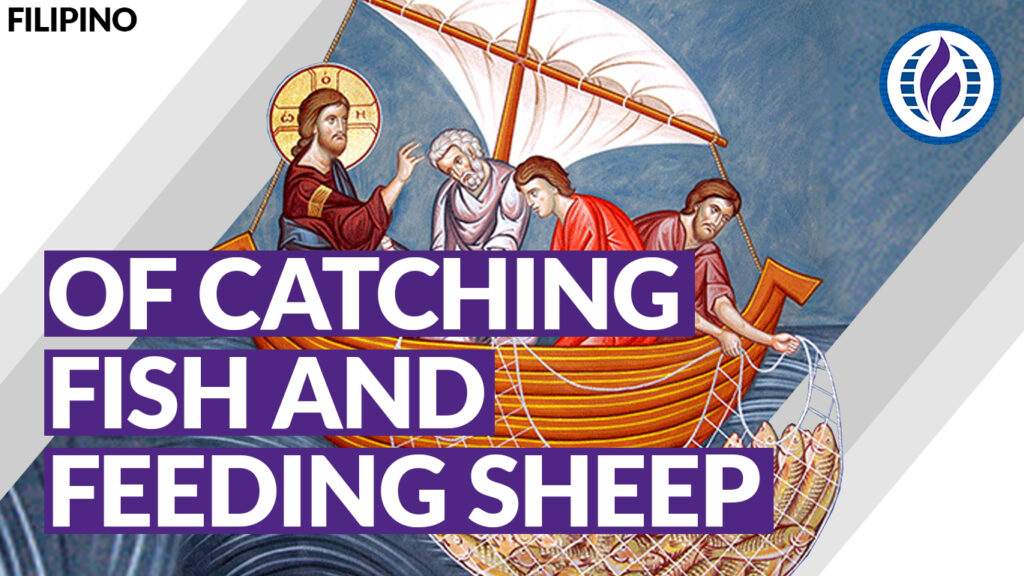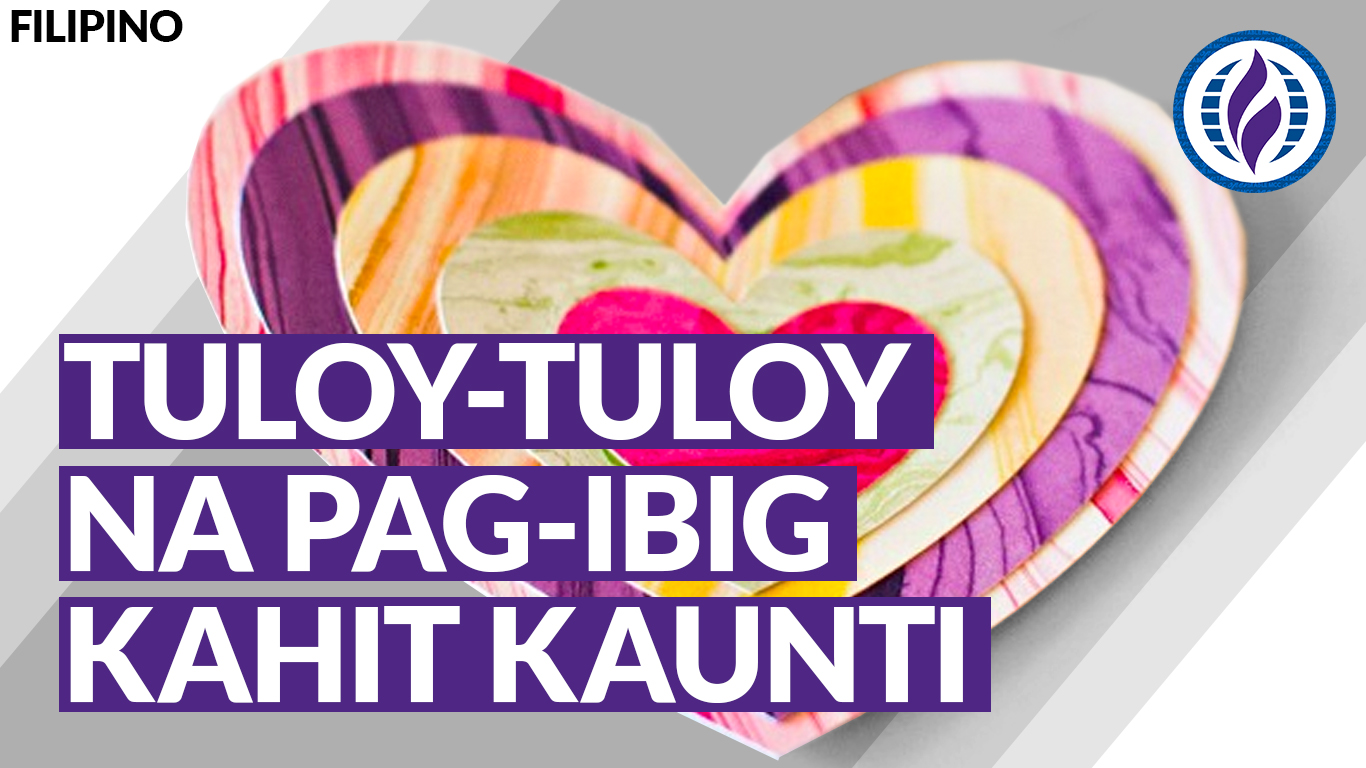After these things Jesus showed himself again to the disciples by the Sea of Tiberias, and he showed himself in this way. Gathered there together were Simon Peter, Thomas called the Twin, Nathanael of Cana in Galilee, the sons of Zebedee, and two others of his disciples. Simon Peter said to them, “I am going fishing.” They said to him, “We will go with you.” They went out and got into the boat, but that night they caught nothing.
Just after daybreak, Jesus stood on the beach, but the disciples did not know that it was Jesus. Jesus said to them, “Children, you have no fish, have you?” They answered him, “No.” He said to them, “Cast the net to the right side of the boat, and you will find some.” So they cast it, and now they were not able to haul it in because there were so many fish. That disciple whom Jesus loved said to Peter, “It is the Lord!” When Simon Peter heard that it was the Lord, he put on his outer garment, for he had taken it off, and jumped into the sea. But the other disciples came in the boat, dragging the net full of fish, for they were not far from the land, only about a hundred yards off.
When they had gone ashore, they saw a charcoal fire there, with fish on it, and bread. Jesus said to them, “Bring some of the fish that you have just caught.” So Simon Peter went aboard and hauled the net ashore, full of large fish, a hundred fifty-three of them, and though there were so many, the net was not torn. Jesus said to them, “Come and have breakfast.” Now none of the disciples dared to ask him, “Who are you?” because they knew it was the Lord. Jesus came and took the bread and gave it to them and did the same with the fish. This was now the third time that Jesus appeared to the disciples after he was raised from the dead.
When they had finished breakfast, Jesus said to Simon Peter, “Simon son of John, do you love me more than these?” He said to him, “Yes, Lord; you know that I love you.” Jesus said to him, “Feed my lambs.” A second time he said to him, “Simon son of John, do you love me?” He said to him, “Yes, Lord; you know that I love you.” Jesus said to him, “Tend my sheep.” He said to him the third time, “Simon son of John, do you love me?” Peter felt hurt because he said to him the third time, “Do you love me?” And he said to him, “Lord, you know everything; you know that I love you.” Jesus said to him, “Feed my sheep. Very truly, I tell you, when you were younger, you used to fasten your own belt and to go wherever you wished. But when you grow old, you will stretch out your hands, and someone else will fasten a belt around you and take you where you do not wish to go.” (He said this to indicate the kind of death by which he would glorify God.) After this he said to him, “Follow me.”
John 21:1-19 NRSVUE
Today’s the third Sunday of Easter. Tayo ay nasa ating serye pa rin ng pag-aaral sa panahon ng Pagkabuhay, “The Gift of Surprise: The Joy of the Unexpected.”
Noong nakaraang linggo, pinagusapan natin ang ikalawa at ikatlong sa apat na appearance stories sa Ebanghelyo ni Juan–ang pagpapakita ni Hesus sa mga disipulo, gayundin ang encounter ni Thomas sa resurrected Jesus. Ngayon, tungkol naman sa ika-apat na appearance stories. Siguro mas mainam na tawagin nating recognition stories ito dahil ito ang mga pagkakataon na nakikila nila si Hesus. They started to recognize the resurrected Jesus, the divine.
This is the “second ending” of the Gospel. It was an addition from the first part of John. Scholars think that this is written by another writer because the language, style, and the vocabulary is different. It is believed that this represents the Galilean tradition independent of the tradition of the Jerusalem appearances. Remember that basically Matthew and Mark had stories representing a tradition of Galilean appearances while Luke and Jn 20 narrate only Jerusalem appearances. When I say appearances – sa Matthew and Mark, sa Galilee lamang nagpakita ang Risen Christ and sa Luke and John 20, sa Jeruslem lamang. Sa Gospel of John, yung first three sa appearance/recognition stories ay nangyari sa Jerusalem; the one we read is set in Galilee, on the shore of the Sea of Tiberias (another name for the Sea of Galilee).
Of Catching Fish and Fishing People:
Seven of the disciples are present, having labored through the night in vain, casting their nets without a single catch. At dawn, a figure appears on the shore—unrecognized by them—calling out and urging them to cast their net on the other side of the boat. They obey, and the net is suddenly teeming with fish, too many for them to haul aboard. That small shift is profound. From nothing to abundance.
In that moment, the disciple whom Jesus loved declares, “It is the Lord.” Moved by recognition and devotion, Peter (being the dramatic) plunges into the sea to reach Jesus ahead of the others.
This scene also calls forth several past instances from the life of the disciples with Jesus. Ang eksenang ito ay nagpapaalala sa atin sa ilang mga naunang eksena at karanasan ng mga disipulo nung nagsisimula pa lamang si Hesus. In John chapter 1, one disciple of John by the name of Andrew, Simon Peter’s brother, was so intrigued that Jesus invited him and another disciple, “Come and see.” Andrew found his brother Simon and said to him, “We have found the Messiah” (which is translated Anointed). He brought Simon to Jesus thus begins their journey with their teacher. In Matthew 4:18-22, this story was set in the Sea of Galilee, the same place where our story in John today was set. Andrew and Simon Peter were fishermen. The story in Matthew continued with Jesus saying to them, “Follow me, and I will make you fishers of people.” The brothers immediately left their nets and followed him. It is like the call of the sons of Zebedee, James and his brother John. They were mending their nets when he called them. Immediately they left the boat and their father and followed him.
This scene of catching fish in the last chapter was a return to their beginnings. They were being reminded of many things. First to go back to how the Jesus movement began. That they were a small group of people who were in the peripheries of society: fisherfolks, peasants, tax collector, rebels. Theirs is a dream to experience shalom, to be free from the shackles of the empire, for their pleas and hopes to be seen, heard, acted upon, and realized.
Second, they were brought back to remember to press on and continue what Jesus started. It was interesting that after the death of Jesus, they went back to fishing. For years, they followed their itinerant teacher and the Messiah they said that they found, the one who told them “Follow me, and I will make you fishers of people.” They are to fish people.
We grew up in a tradition that this is the call to mission of the disciples. What Jesus did in the text we read is to remind them not to be distracted by fear, to not divert their energies from things that matter.
Of Sheep Feeding and the Threefold Question:
Upon their arrival at the shore, they find a meal prepared— bread and fish laid out by Jesus himself. After they have eaten, Jesus turns to Peter and begins a solemn exchange. Three times he asks, “Simon, son of John, do you love me?” And three times Peter affirms his love. To each affirmation, Jesus gives a charge: “Feed my lambs,” “Tend my sheep,” “Feed my sheep.”
Weeks ago, Jesus predicted that Jesus would deny him. Again, dramatic Peter exclaimed that it cannot be. Sya? Itatatuwa si Hesus? And true enough, on the night that Jesus was arrested, thrice did Peter deny that he knew Jesus. The denials were closed by a rooster crowing.
Sympathetic ako kay Peter. Gets ko na he felt hurt dahil paulit-ulit yung tanong ni Hesus na “Do you love me?” Kaya nga diba ang reply nya ay “Lord, you know everything; you know that I love you.” Siguro na-gets na rin ni Peter yung thrice na pagtanong ay baka equivalent sa thrice niyang pag-deny.
Pero, I do not view this as a reminder of Peter’s failure. It is a moment of redemption. This is the grace of resurrection. We are offered not just forgiveness, but restoration.
In John chapter 10, which we will further discuss next week, Jesus described himself as the good shepherd, we are his people, his sheep. Now, Jesus was telling Peter to feed and tend his sheep. The one who failed is now the one commissioned. He was reminded to continue caring and leading the flock. To seek the lost. To protect them. To lay his life for them, just as how the good shepherd, Jesus, would do.
Follow Me.
Then Jesus speaks in veiled terms, foretelling Peter’s fate—hinting that he too will suffer and die by crucifixion (at least that’s how that verse has been interpreted). Stories from oral tradition tell us that Peter felt unworthy to die like Jesus so pinabaliktad nya ang krus nya and he was crucified upside down – as tradition says – sa Vatican Hill. So, hmmmn… Extreme evangelicals, take note.
As the dialogue closes, Jesus issues a final, profound summons: “Follow me.” Twice repeated, these are the last words he speaks in the Gospel of John—a call to discipleship unto death, to walk the path he himself has trod.
Last week, in our preaching, we have mentioned that the first words of Jesus to the disciples in John’s gospel are, “What are you looking for?” (1:38). This is after two disciples of John followed him after the prophet exclaimed “Look, here is the Lamb of God!” We also discussed that in the middle of the gospel, when Thomas asked how they can know where Jesus was going, Jesus says, “I am the way” (14:6). And now, at the end, of the Gospel Jesus says, “Follow me” (twice, 21:19, 22).
At the heart of John’s Gospel is the idea of “the way.” If we would recall, Jesus speaks directly about the need to be “born again” (John 3:1–10), and later, he uses the image of a seed that must fall into the ground and die to produce fruit (12:24). He even calls this the only way (14:6)—a verse that has sadly often been used to promote an exclusive and triumphalist view of Christianity.
Sa evangelical theology, dinideal yung death and resurrection ni Jesus bilang parang legal settlement sa debt. Binayran ni Jesus ang kasalanan sa pamamagitan ng kamatayan; pero napagtagumpayan niya ito. Pero di lang iyon tungkol doon. Alam natin na sampal sa imperyo ang resurrection. The resurrection of Jesus is more than that.
Within the broader vision of John’s Gospel—rooted in the idea of God becoming flesh—the death and resurrection of Jesus show us the true nature of transformation. “Be born again,” “unless a grain of wheat falls into the earth and dies, it remains just a single grain, but if it dies it bears much fruit.” To say “Jesus is the only way” is not to shut others out, but to point to the pattern revealed in him: dying to the old self and rising to new life. This, above all, is the journey of personal transformation.
To follow Jesus is to be transformed, to change our old ways and be more in line with the character of Jesus. Follow the teacher, his examples. Hindi ito madali. For Peter, it means leaving his impetuous ways to the point that he will even stretch his hands to lay down his life on a cross. To us, it is to die like a grain of wheat and be changed, reborn. And we are reminded of this sa last chapter of the Gospel of John, this 2nd last chapter. We are reminded that instead of going back to what we were doing and who we are before meeting Jesus, we are reminded not to regress far back, but merely to go back and remember why we followed Jesus in the first place and how following him transformed us. How we were born again (as many times over) throughout the journey around Galilee, into Jerusalem, towards the cross and finally out of the tomb.
Now, to us today, let us reflect. Where should we return to? Saan tayo babalik para alalahanin bakit tayo naririto ngayon? Where is our Sea of Galilee? Ano ba ang simulain natin bilang isang mananampalataya, bilang isang simbahan ng mga taong itinakwil sa mga pinanggalingang simbahan? Let us go back to our roots, our beginnings with Jesus; our beginning with Jesus in Open Table MCC. What has God called us to do? It can be something not grand, as simple as being a good neighbor, offering our homes to others, lending our shoulders, extending our hands to help. Selling Drag Bingo tickets to extend love and service sa darating na panahon ng tag-ulan. To love one another to prove that we are his followers. It can be as straightforward (though challenging) as our triple mission to maintaining a safe and welcoming Church community and space for everyone, to joyfully and prophetically proclaim the radically inclusive love of God for all people, and to participate in God’s greater and wider work of justice and peace.
When “Christianity has contributed to racism, sexism, nationalism, exclusivism, and other harmful ideologies,” what does it mean to be a Christian today? Marcus Borg, in “The heart of Christianity: rediscovering a life of faith,” said
Christianity is a way of life; that is its heart. To be Christian means living “the path” within this tradition. At the heart of Christianity is the way of the heart—a path that transforms us at the deepest level of our being. At the heart of Christianity is the heart of God—a passion for our transformation and the transformation of the world. At the heart of Christianity is participating in the passion of God.
Podcast: Play in new window | Download
Subscribe: Apple Podcasts | Spotify | RSS



